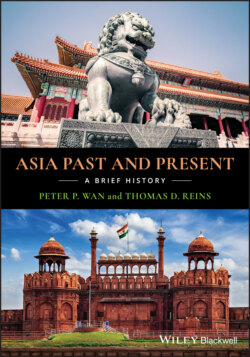Читать книгу Asia Past and Present - Peter P. Wan - Страница 23
Ancient Indian Civilization
ОглавлениеAcademics still do not agree on which civilization in Asia possesses the longest continuous history. Certainly civilization in India began long before China’s, but did it continue unbroken down to the present? Indus Valley civilization, sometimes referred to as Harappan civilization and at times as Indus‐Saraswati civilization, originated about 3000 BCE along the Indus River and its tributaries in what is now Pakistan and northwestern India. It collapsed approximately 1500 BCE. Did the essence of that collapsed civilization continue to animate the subsequent Aryan culture of uncivilized, tribally organized people who entered India about that time from Central Asia and came to dominate India thereafter? Or did the Aryans basically create a civilization of their own with little or no input from the Harappan past? If the Harappan past fundamentally guides the Aryan future, then Indian civilization is continuous and thus longest. If not, China warrants the longevity distinction.
Indus Valley civilization, 2600–1900 BCE.
Source: McIntosh, Jane. (2008). The Ancient Indus Valley: New Perspectives.
Evidence for civilization in ancient India, first hit upon in the mid‐nineteenth century, comes chiefly from archaeological excavations conducted in 1921 and 1922. These digs revealed two major cities whose origins date back to the third millennium BCE. Harappa, apparently the model for most other Indus Valley cities, was unearthed along the Ravi River, a tributary of the Indus in northern Pakistan. Mohenjo Daro, the second major site uncovered, was found along the Indus in southern Pakistan. Subsequent excavations have brought to light another 1500 sites, two‐thirds of which are along the now‐desiccated Saraswati River, and the oldest of which is Kalibangan, located in northwestern India. Given Indus Valley civilization’s proximity to the older Mesopotamian culture, the question of originality arises, since contact between the two existed. Here, too, whether Indus Valley civilization emerged on its own or owed its creation to outside influence will not likely be settled until the Harappan script is deciphered.
What do we know about India’s earliest city life? The Indus River, which originates in the Himalayan Mountains, provided reliable access to water for both animal (humans, dogs, cats, cattle, and eventually horses and camels) and plant life (wheat, melons, peas, barley, rice, and other fruits and vegetables). The Indus and its tributaries also supplied dependable flooding that deposited fertile topsoil on nearby cropland. Consequently a plentiful quantity of food made it possible for the rural majority of farmers to support an urban minority of non‐farming occupations. This symbiotic relationship resulted in a community of differing occupations bound together by an attitude of shared interests and values.
The cities, which appear to have been well planned, were divided into two distinct parts: an elevated citadel for the city’s defense and refuge, and the lower city itself, which was organized along a grid pattern. Spacious homes made of brick contained drainage systems, verandas, living/bedrooms, and work areas, thus providing a fair amount of domestic comfort for many inhabitants. High‐quality roads within each city made transportation and travel in the roughly five‐ to six‐square‐mile city relatively easy, while the Indus facilitated contact among the various city‐states (which stretched more than a thousand miles along the river) as well as with the wider world, the gateway to which was the Arabian Sea, into which the Indus flows.
Unearthed artifacts such as pottery, seals, and tools (as well as the absence of some remains) offer clues to some of the thinking and behavior of these early Indians. The lack of remains signifying the presence of palaces strongly argues against the existence of a strong, awe‐inspiring ruler, either in any particular city or among clusters of city‐states that emerged in the ancient civilizations of Mesopotamia, Egypt, and China.
According to one scholar of India, “Trade seals with signs from the Harappan writing system have been found not only in the major cities of the Indus‐Saraswati civilization but also overseas or overland at Ur in Babylon (South Iraq), at Ebla in North Syria and at numerous ports in the ancient Persian Gulf.”3 Apparently merchants and mercantile activities constituted important parts of the social order in these cities. Moreover, the Indus Valley writing system, seals, and pottery make a strong statement of orthographic and religious continuity. By 2000 BCE along the river corridor, it appears that Indus Valley civilization had reached its point of greatest development.
How did Harappan civilization collapse? Several theories, none of which are mutually exclusive, attempt to explain the disappearance of the numerous city‐states for nearly 3500 years. One speculation asserts that prolonged drought, evidenced by the drying up of the Saraswati River, compelled Indus Valley residents to migrate east in search of a more farmer‐friendly environment. Another theory stresses the likelihood of massive flooding either caused by unusually large amounts of Himalayan snowmelt or due to a tsunami from the sea. Given the nearness of the city‐states to the Indus or its tributaries, such scenarios could have spelled doom for urban occupants. As well, a massive earthquake in this earthquake‐prone area could have destroyed the region. Furthermore, the Aryan invaders from Central Asia had the potential of overrunning these hundreds of city‐states. And finally, any combination of these catastrophes, not all simultaneously but over time, could have eroded and then destroyed the framework of Indus Valley civilization.
